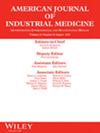The Psychosocial Hierarchy of Controls: Effectively Reducing Psychosocial Hazards at Work
Abstract
Background
Psychosocial hazards in the workplace contribute to mental disorders, cardiovascular diseases, and musculoskeletal ill-health. The Hierarchy of Controls applied to NIOSH Total Worker Health (TWH HOC) aims to mitigate these hazards through effective interventions. This study proposes a revision of the model resulting in a HOC for psychosocial hazards (P-HOC) and explores its application in improving the working environment.
Methods
We reviewed recent literature on organizational and individual interventions to revise the TWH HOC to a psychosocial HOC framework. Subsequently, the modified P-HOC was applied to a qualitative case study of nine Danish companies participating in the Danish “Agreement to problem-solve” labor inspection strategy. We analyzed the types of initiatives implemented and gathered qualitative data on employee and management perspectives on their effectiveness.
Results
The study led to a revision of the TWH HOC resulting in a P-HOC prioritizing organizational measures with documented effect, and indicating the importance of comprehensive measures. Findings from the qualitative study indicate a predominant contemporary focus on lower-level P-HOC initiatives, such as individual-based approaches and administrative controls. While these interventions show some improvements in mental well-being and work culture, they seem insufficient to enhance the comprehensive psychosocial environment. Companies implementing higher-level interventions experienced greater efficacy, particularly when employing multifaceted approaches.
Conclusions
The study emphasizes the need for a more robust application of higher-level measures and multifaceted interventions to better improve the psychosocial working environment. Future research should investigate the P-HOC's varying impact and explore alternative frameworks for better intervention outcomes.


 求助内容:
求助内容: 应助结果提醒方式:
应助结果提醒方式:


